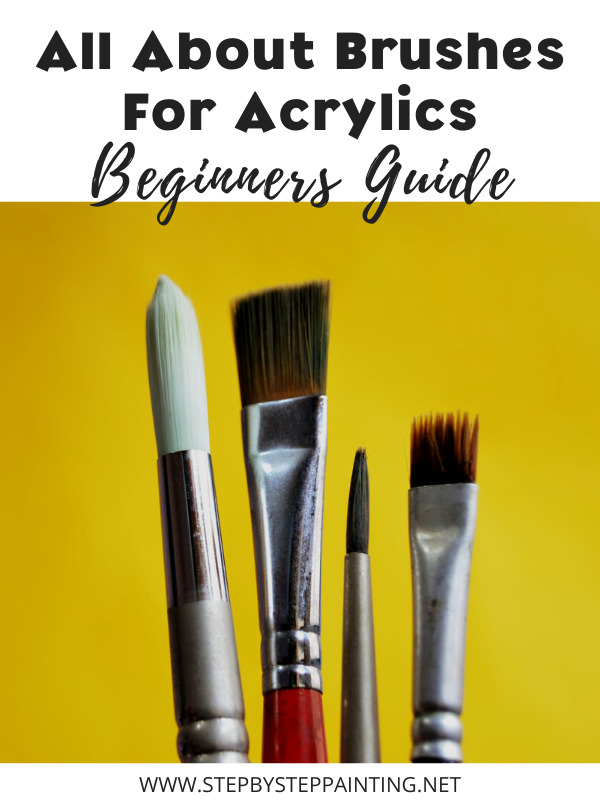
Would you like to save this?
Learn the absolute basics about brushes for acrylic painting! I often get asked which brushes would be the best when starting out with acrylics.
If you search online or go to the brush aisle at any arts & craft store, it can get overwhelming.
There are so many styles, shapes and sizes of brushes on the market!
Scroll down to see my two favorite brush brands!
A lot of beginner acrylic painters will grab a basic 10 pack of brushes at the craft store. That is a great starting point and there is nothing wrong with that.
However, when you dabble deeper into painting you may find that you want to invest a little more in a quality brush that will perform a certain technique well. Or, you may find that you don’t need all the sizes in that pack.
This post will introduce you to the types of brushes there are and things to consider when it comes to selecting brush sizes, materials of the bristles and brush styles.
Bristle Material For Acrylics
When selecting a brush, I recommend that you go the synthetic route because the material can withstand constant moisture and cleaning from the acrylics.
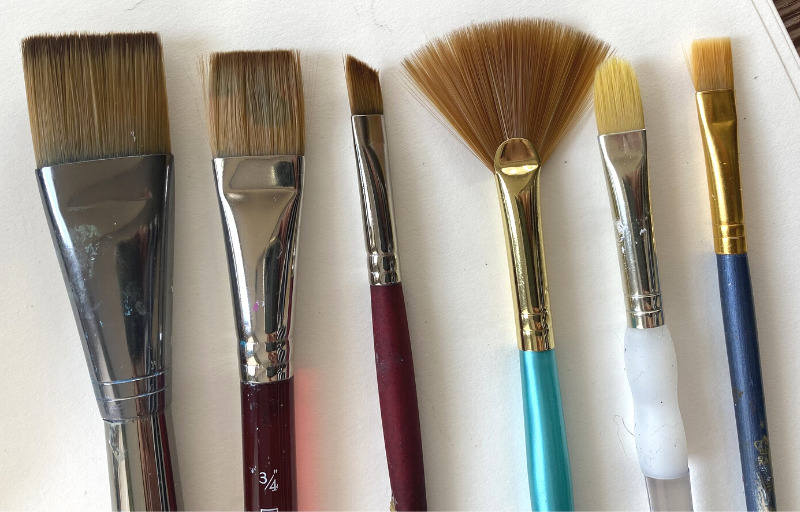
Acrylic paint brushes are often made of synthetic materials. These materials include “taklon”, “nylon”, “polyester” and “synthetic sable”. I love the synthetic sable brushes because they are extremely soft and hold a lot of paint!
I almost exclusively use synthetic brushes for acrylic painting with the exception of a bristle brush every once in awhile to achieve certain textures. Synthetic brushes will be able to withstand the harsh acrylics and constant rinsing & washing.
Bristle brushes are typically made of hog hair and have rough, stiff and scratchy bristles. These brushes will show the rough paint strokes on the canvas. I typically only use a bristle brush when I want to apply heavy textured strokes to the canvas but they are not ideal for blending and creating smooth strokes.

Short Handle Vs. Long Handle For Acrylics
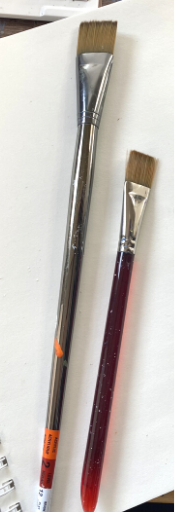
Paint brushes can have long handles or short handles. I actually don’t have a preference for one over the other but some artists do.
A long handle gives you the ability to paint further away from the canvas while a short handle is lighter to hold and seem easier to control.
Brush Shapes & Sizes
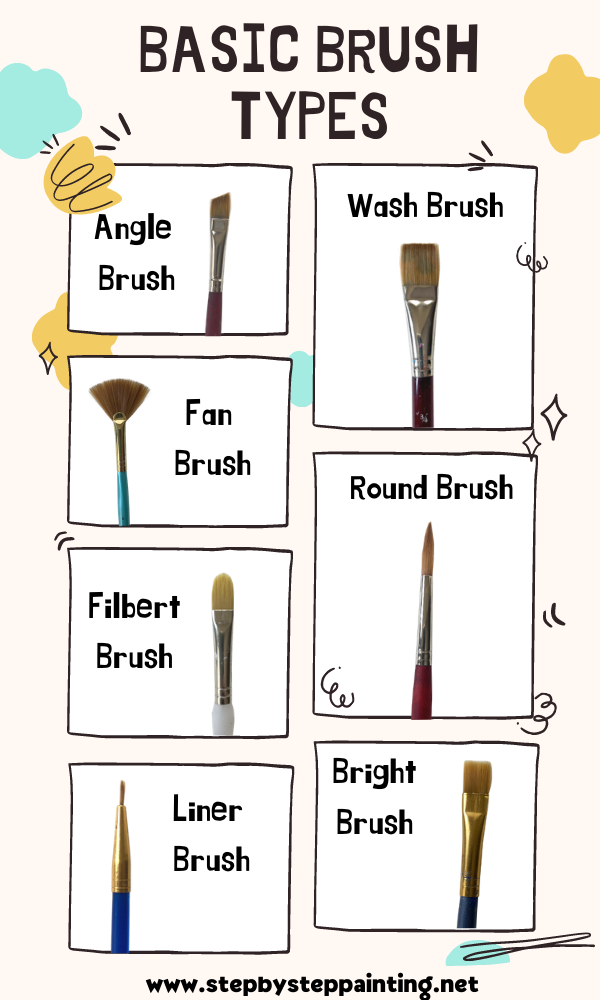
This is where things get very detailed and often confusing! Brushes come in so many shapes and sizes. It’s important to have a nice variety of brush sizes so that you can achieve different effects in your painting.
Here are the different size brushes for acrylic painting.
Wash Brush
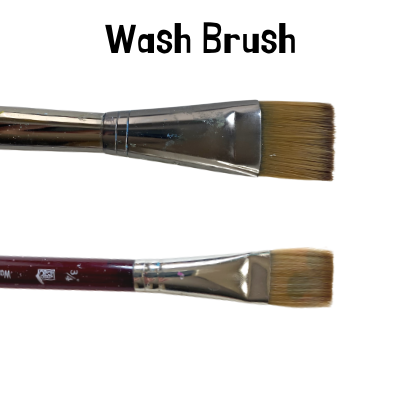
A wash brush is flat and wide and it is often interchangeably called a “flat brush” or a “flat wash brush”. The most common wash brush I use is the 3/4″ Flat Wash Brush. However, you can find wash brushes in a lot of sizes such as 2″, 1″, 1/2″, 1/4″, etc.
Sometimes the 3/4″ Flat Wash is not wide enough for painting on larger canvas sizes so if you feel that is the case for you, I recommend looking for an 1″ size.
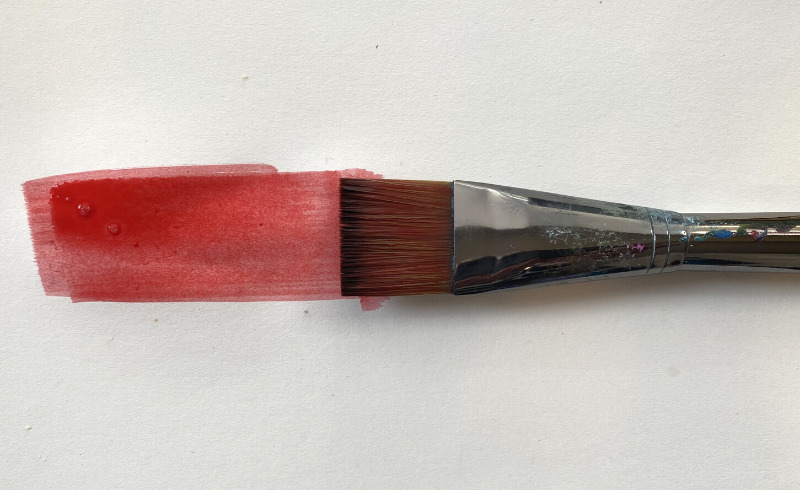
All wash brushes hold a lot of water and paint and fill up an area fast. It is mostly used for painting a background in a painting but sometimes used for other large areas.
Bright Brush

A bright brush is also a flat brush but the bristles are shorter. These are great brushes for beginners because they are easier to control.
You can get a bright brush in different sizes and often they are labeled with a number like “#4 bright”, “#12 bright”, etc.
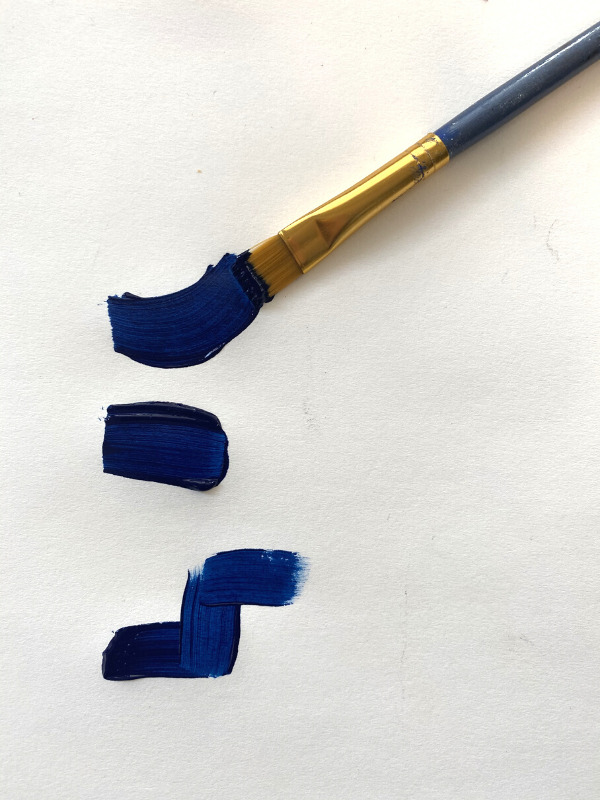
The most common bright brush I use in paintings is the “12 bright”. The bristles on this brush are about 1/4″ wide.
Bright brushes are versatile and can be used for painting tree branches, medium sized objects, pine trees, etc. Because the bristles are short on these brushes, they are easier to control and make more precise brush strokes.
Angle Brush
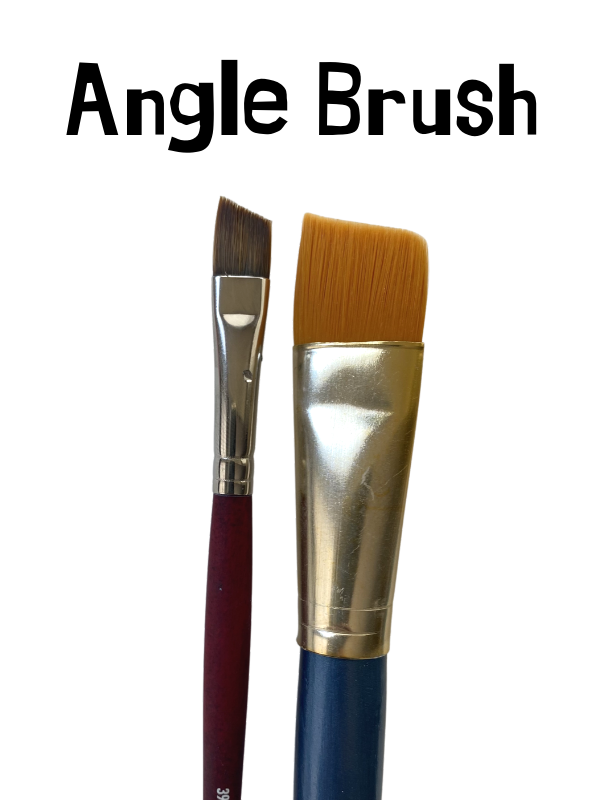
Angle brushes are great because you can use them to create precise strokes and vary the thickness of your strokes. Use an angle to “cut in” on an object for filling in, use them for tree branches, etc.
They are versatile because you can paint thin lines and thick lines just by changing the way you are holding the brush.
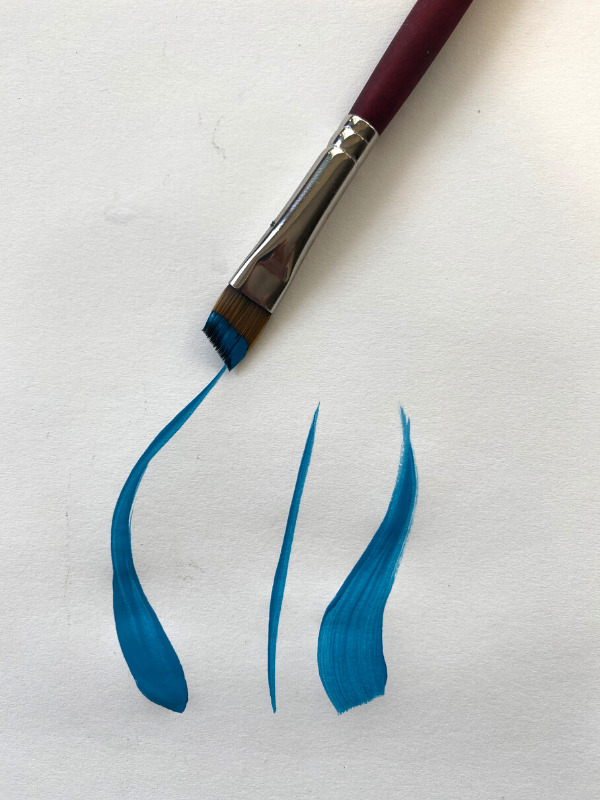
Angle brushes are typically labeled with an inch number. I use a 3/8″ angle brush but also the “1/4”. You can, of course, find larger angle brushes.
I have a whole tutorial dedicated to how to paint tree branches with an angle brush. You can see that post here!
Round Brush
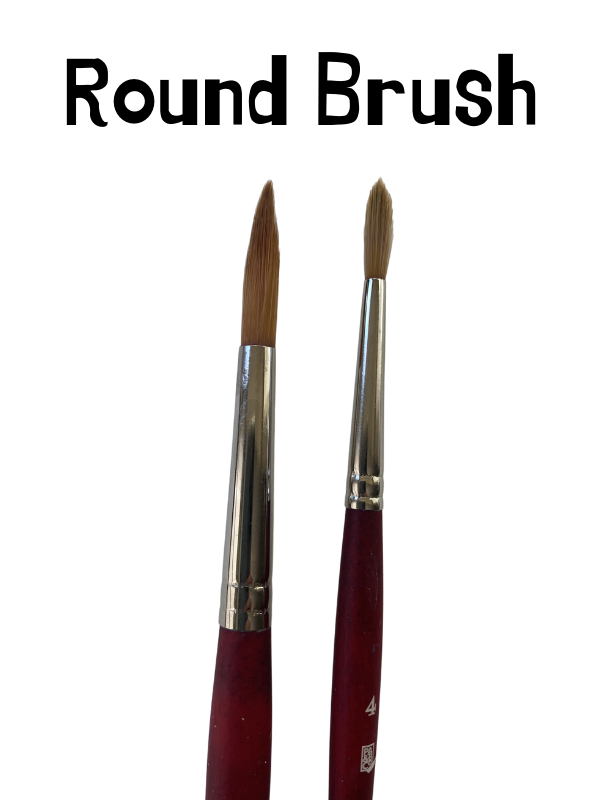
The most popular brush for painting with acrylics is the round brush! These brushes come in so many sizes and are often labeled as a number. The larger the number, the larger the diameter of the brush.
A larger round brush can achieve painting in larger areas but also smaller areas because most round brushes have a nice tip to them.
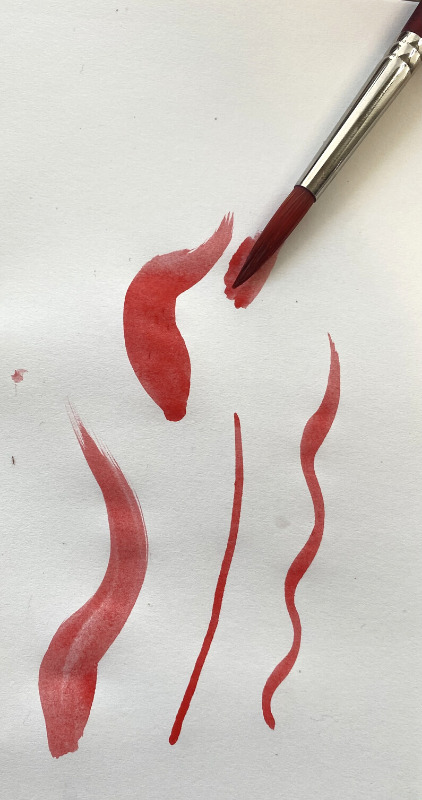
The most common size round brush that I use is the #4 round brush. I find this size capable of filling in both large and small areas and the tip can be used to achieve small outline techniques.
I also grab my #8 round brush in this Princeton Velvetouch Set because it has a nice tip to it which means it can also paint very thick and very thin lines all with the same brush.
You can use round brushes for painting tree branches, painting in organic objects, stippling landscape textures, painting water, etc.
Spotter & Liner Brushes
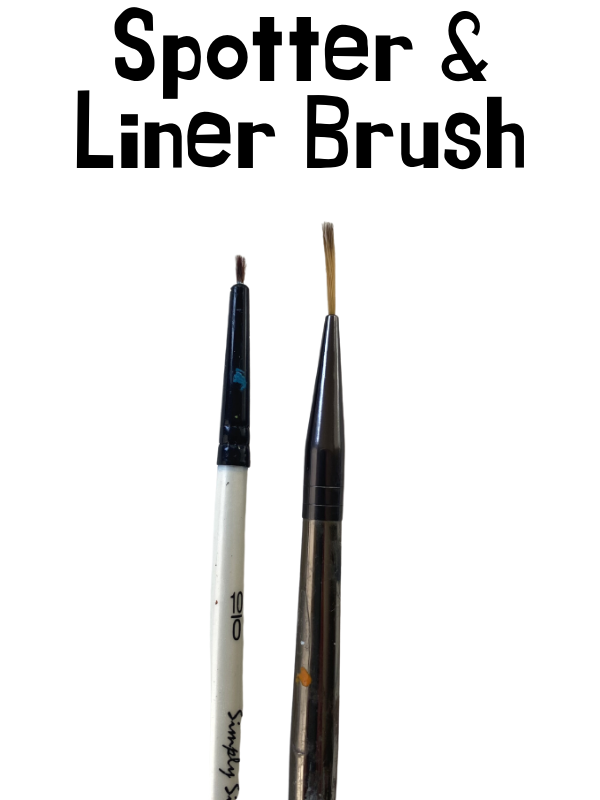
In the round brush category you also have tiny round brush sizes such as 0, 5/0, 10/0, etc. These tiny round brushes are used for detail work and outlining.
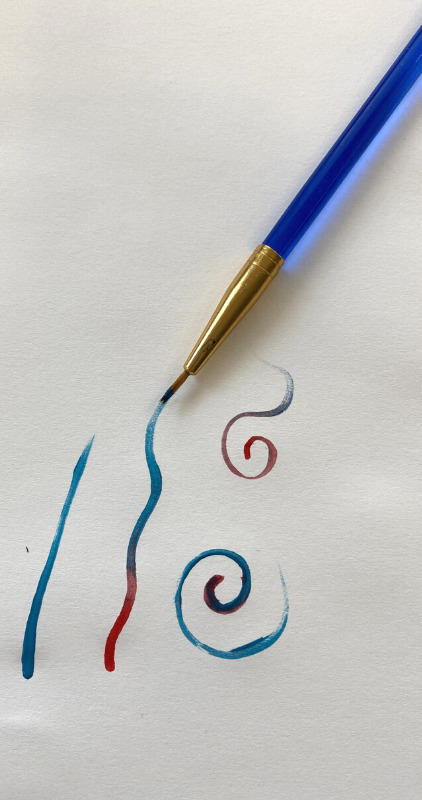
The difference between a spotter and a liner is that the spotter has shorter bristles and the liner has longer bristles. Some prefer the spotter because the bristles are easier to control. However, the “flow” on the spotter brush may not be as good as the “liner” because you are working with less bristles to hold the paint.
These brushes can be kind of hard to use because of how tiny the bristles are. You need a steady hand to get those thin lines. A lot of times I recommend using a paint pen for beginners in leu of the liner brush because the paint pen allows for easier control of the tiny lines.
If you are interested in learning more about paint pens in acrylic painting, you can check out my post about the POSCA paint pens!
Fan Brush
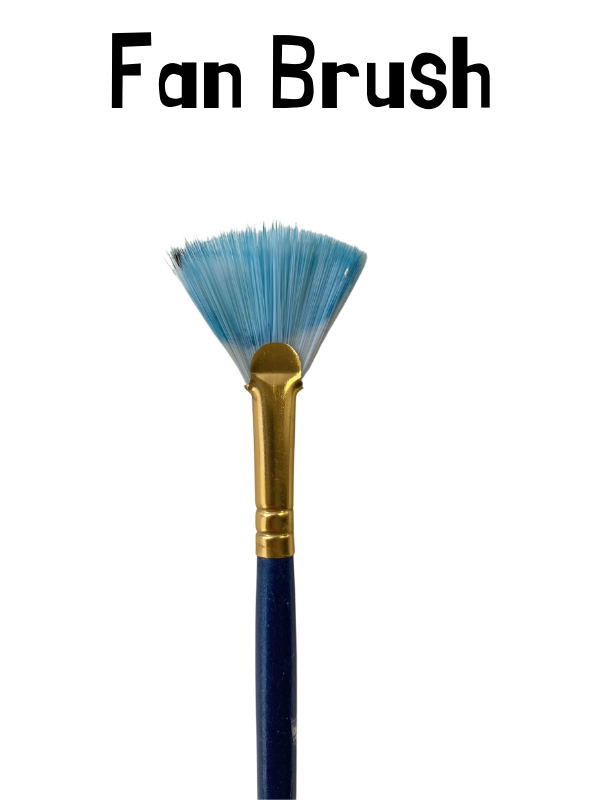
The fan brush can achieve unique effects and are a great brush for painting trees and different textures! Beginners often find this brush intimidating but once you get the hang of it, it is a great brush to use in many landscape paintings!
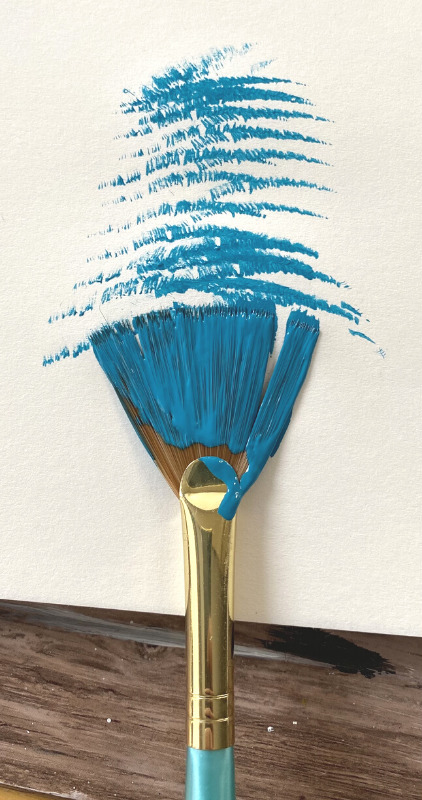
These brushes are also labeled as a number. I typically use a #4 fan brush or a #6 fan brush. The larger numbers tend to be more larger and spread out.
If you are interested in learning how to paint trees with a fan brush, you can check out my tutorial for that here!
Filbert Brushes
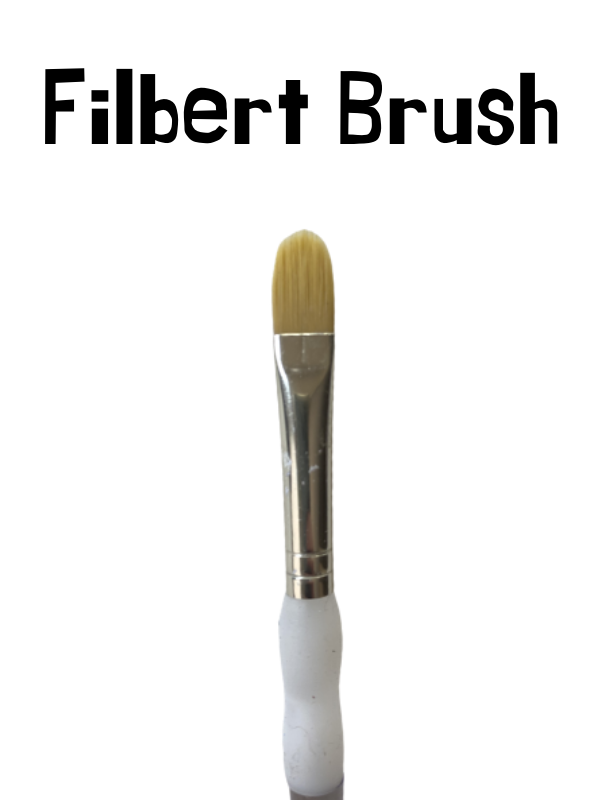
A filbert brush is kind of a cross between a flat and a round brush. The bristles are flat but the tip of the bristles are rounded.
Filbert brushes can create unique rounded strokes and are great brushes for painting flowers. If you are looking to achieve the look of a short stroke achieved in a flat brush but with a rounded edge, the filbert brush is perfect for this effect!
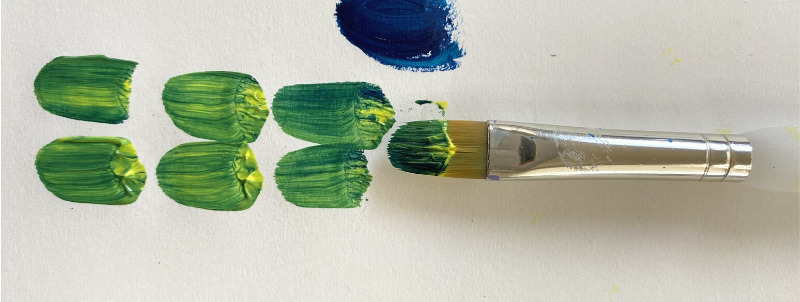
Palette Knife
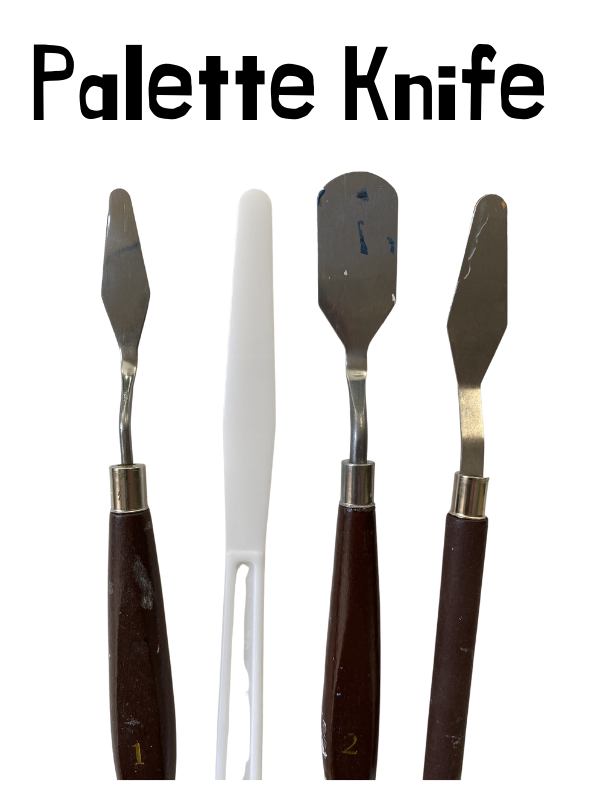
A palette knife is a tool that can be either flexible metal or plastic. It is used to create unique, thick textures with acrylic paint such as in impasto painting. Palette knives can also be used to mix colors on your palette.
You can get palette knives in a variety of sizes and shapes. They are often labeled with a number to represent their shape.
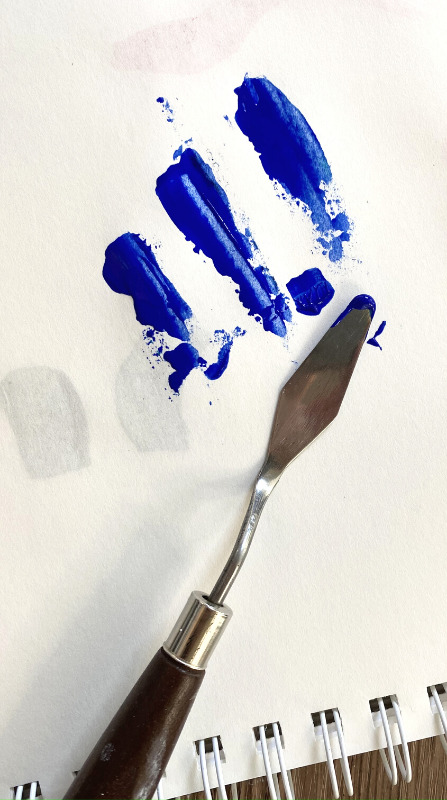
Palette knife painting is a whole technique that I do not teach on this website but I occasionally grab a palette knife to achieve thick strokes in some of my landscape paintings such as these birch trees.
Vincent Van Gogh was known for using the palette knife in his paintings and it is how he was able to achieve such thick textures in his masterpieces.
Other “non-conventional” brushes

It is absolutely okay to use something that is not intended to be an artist brush! Sometimes objects around the house, such as a sponge or q-tip, can achieve a certain effect you cannot create with a typical paint brush.

Q-Tips can be used for “stipple” painting such as in a Cherry Blossom Painting.
A makeup brush can be used to create a galaxy or blended background because of how soft the bristles are!
A sponge can be used to create interesting textures or fill up a background area fast.
Round pouncer sponges can be used anywhere you need perfect circles in your painting (a sun!). You can also use these to create the “bokeh” effect.
Sometimes even using your fingers makes for interesting techniques such as blending and smearing!
Finally, the good old toothbrush is no stranger to my tutorials. I often use it for splattering stars in a sky, snow or water splashes.
My Two Favorite Brush Brands For Beginning With Acrylics
My two favorite brush brands I like to recommend to beginners that are just starting out with acrylics are the Royal & Langnickel Zen line of brushes and the Princeton Velvetouch line of brushes.
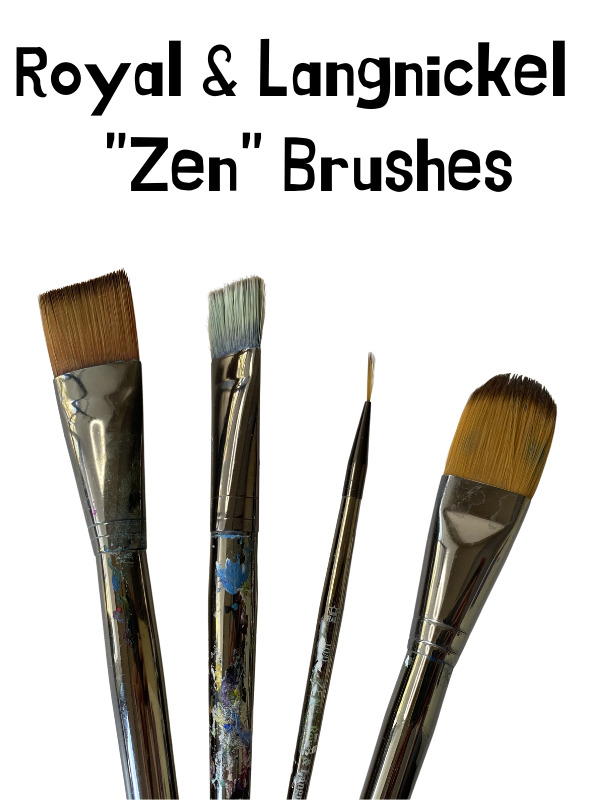
The Zen brushes are very popular! These brushes have the silver color handles and the soft, synthetic bristles. The price point is great for a beginner just starting out and wanting to try the brushes but not ready to spend a lot on brushes. You can get these in packs and also as individual sized brushes.
I recommend going to your local arts & crafts store such as Michaels and searching in the brush aisle. They sell these in individual sizes.
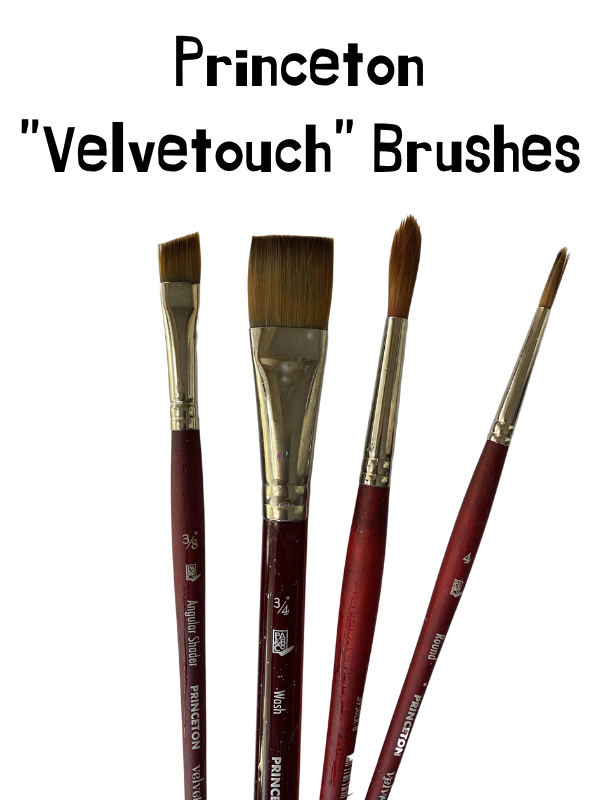
The Princeton Velvetouch are my favorite but they are pricier. They are extremely durable and I absolutely love the quality of the bristles. What I love most about these brushes is how lightweight and soft the handles feel. The bristles are also very soft but still keep their form/ spring back to their shape fast. The four pack includes 4 very common brushes I use in my tutorials.
Proper Brush Care
You want to check with the brand of your brush to see if they give directions for how to properly care for the brushes. Often instructions will be labeled on the back of the brush pack or even on the manufacturer’s website.
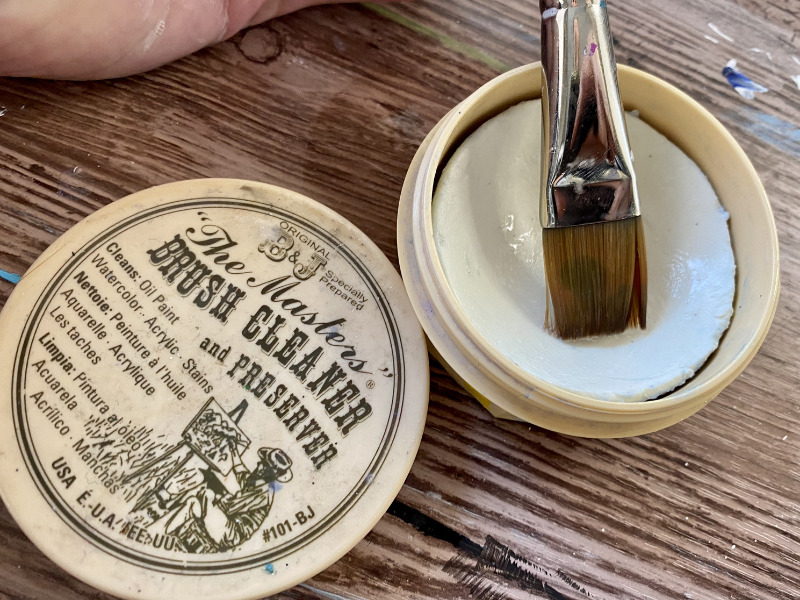
The standard is to immediately clean the brushes after your painting session. I use a cleaner called “The Masters Brush Cleaner”. I keep this by my kitchen sink and wash my brushes with this.
If I am in a hurry, I’ll use liquid hand soap to clean the bristles and that tends to do a good job at getting all the paint off.
Try to dry your brushes so they are slightly elevated downwards. This is because you do not want the water running down the “ferrel” and loosening the glue to the point where the brush literally falls apart.
After dry you will want to store the brushes facing upwards or flat. Just make sure the bristles are not being obstructed or they will dry bent.
I store my brushes in cups and jars or the original brush pack they came in.
If you accidentally leave your brush in a dirty water jar or with paint that dried overnight (it happens) most likely there still is a way to salvage them.
Simply rinse and clean right away. If the paint has dried try soaking the brush in water and then using “The Masters Brush Cleaner” to clean out the dried up paint. It may not be too late to get the dried paint off (unless it’s been dried on the brush for months).
Further Reading
If you want to learn more about basic brush techniques and practice, you can see my posts about flat brush techniques and round brush techniques.

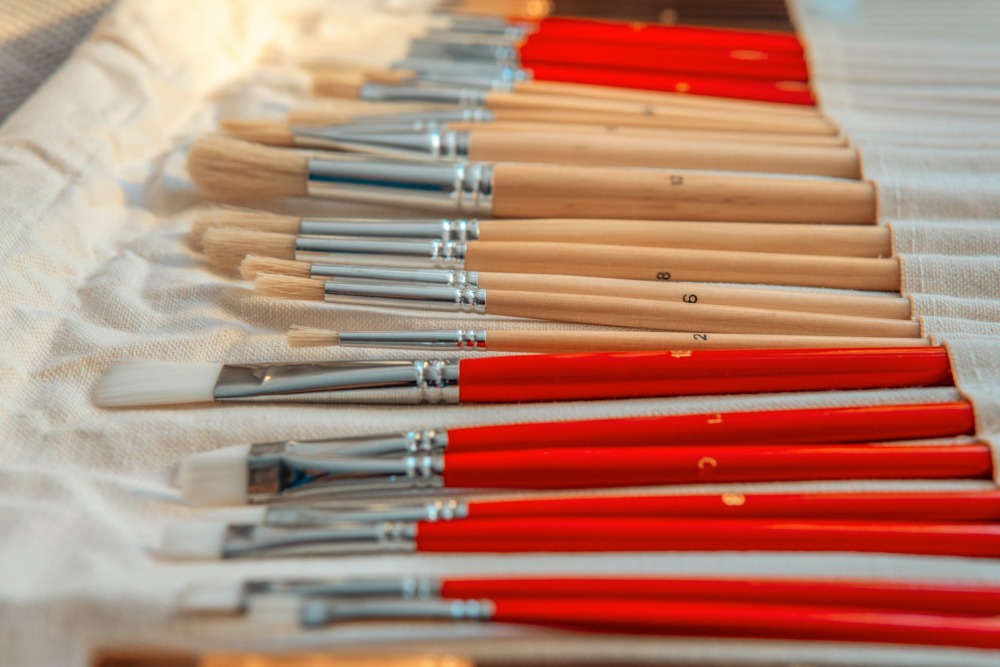
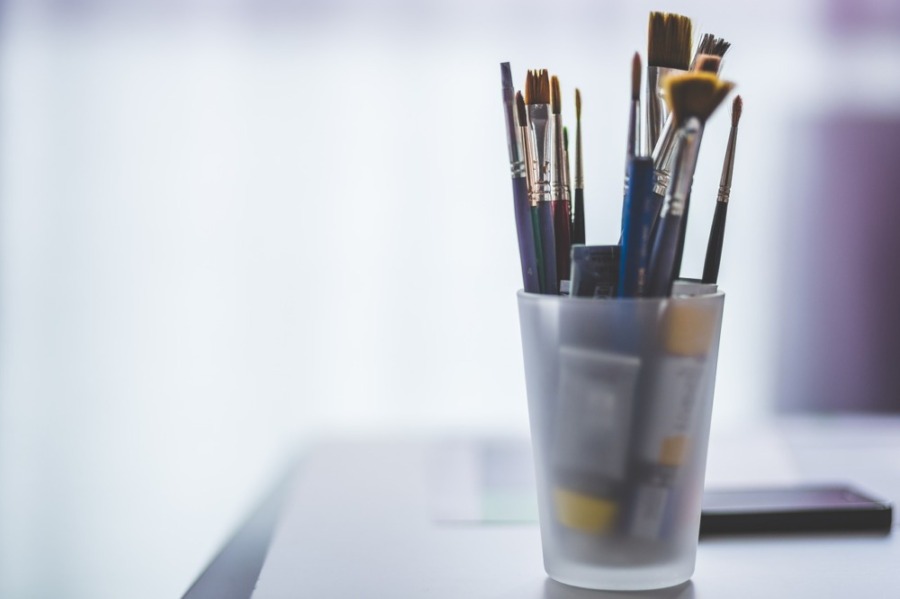
HI Tracie…I am a beginner acrylics fan just gathering information and starter supplies…KUDOS TO THIS INFORMATION on types of brushes etc..Best post Ive found over past 2 weeks..just wanted to say thks for the tips! Love your syle!!!
You are so very welcome!!
You’re the best and clearest tutor ever, and I did a 2 yr course in mixed art, but this was never taught. Thank you so much
Fiona England
I agree , I have been on other sites and I can say your video made selecting the right brushes easy .
Very helpful! I’ve been scouring your site and others, trying to figure out how to handle the brushes and load them better. Definitely like the tutorial videos! I haven’t taken an art class in…a few decades ?
Thank you 🙏 for your very informative & helpful info for beginners of acrylic painting such as myself. I found your advice on the topic of proper choice & use of paintbrushes most insightful & rewarding to me, personally!
Thanks 🙏 again! I know where to look 👀 now for future tips & help!!
Slef taught beginners like me can learn many things here, thanks for sharing. Helpfull. ❤️
Thank you for all the information you provide. I am a home school mom (and love painting myself) trying to teach my children the basics. Your sight is not only terrific for them, but also for me. Thank you again for having this sight available. I’m proud to be a member.
Sincerely,
Scarlett Deal
Hi Tracie
I have always wanted to paint. Often l just sit staring at the blank canvas. I happened to ‘stumble’ across you magnificent & very informative website with so much information & tutorials. Best of all, it’s free. I bought the Princeton brushes so long ago but have never used them – too scared to. I might try now tho’.
Thank you so much for creating your website and tutorials. I am your new No. 1 fan. Your website has now become my ‘Teacher’.